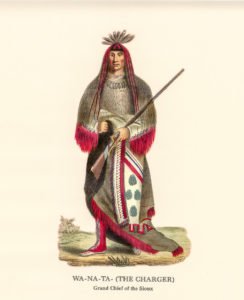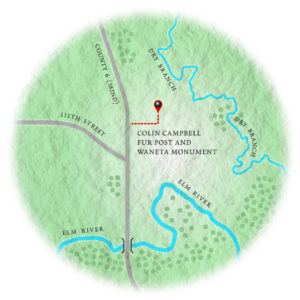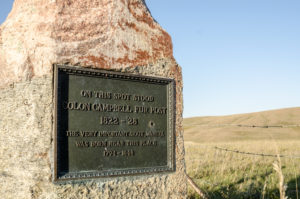


Wa-Na-Ta, the Charger, Grand Chief of the Sioux. This colored lithograph was done as part of a collection of lithographs and biographies of important Native Americans in 1836. The volume, Indian Tribes of North America, was published by Thomas McKenney and James Hall of Philadelphia. The artist is credited as Charles Bird King, however, the lithographers obviously interpreted Waneta themselves.
Before any settlers arrived and before Aberdeen was a city, all of the United States was Indian territory. Many stories remain untold about Native American leadership in our area and early interactions between Native American bands and non-Indian immigrants in the Aberdeen and Brown County regions. This story, and a follow up story in the next issue, reveal this history of Indians who, at times, resisted settlement to preserve their way of life, but also tried to figure out treaty negotiations and alliances with settlers and encroaching nations to protect their people and way of life in the James and Elm River Valleys.
In 1795, Waneta, a member of the Cut Head band of Yanktonai Dakota Sioux, was born in a village along the banks of the Elm River between the cities of Columbia and Frederick in what is now Brown County, South Dakota. His father, Red Thunder, was a war chief of this band. As a young man, he watched his father welcome both British and French trappers, traders, and explorers into his territory, which extended from the James River Basin near Redfield north through Pembina, North Dakota.
At this time, British trappers were utilizing gifts and presents to win the loyalty of tribal members throughout the region as a strategy to secure their allegiance to Britain’s cause against American settlement. One particular trader, Robert Dickson, was said to be the only such trader dispatched with virtually unlimited funds for this purpose. He also was able to successfully assert great influence by advancing claims that the Great Spirit had sent the British to help tribes eradicate encroaching American settlement. This combination of factors strengthened the relationship between Waneta’s people and the British.
Because of their strong relationship with the British, Waneta, who was merely 17-years -old, went with his father and a number of warriors to support the British in the war of 1812. A M’dewakanton Dakota and Dickson’s official interpreter, Joseph Renville, aided in recruiting warriors for this purpose. They rode close to 1,000 miles to fight at the siege of Fort Meigs in 1813 at Sandusky, Ohio. It was at Sandusky that Waneta established his legacy for greatness. The British charged the American position with Waneta leading the way. Waneta received nine serious injuries, six of which were caused by musket balls, including one that entered his chest, glanced off his breastbone, and exited his back. Despite these wounds, he pressed forward and killed seven men in hand-to-hand combat. It was because of this impressive display that Waneta received his name (variously spelled as Wan-ee-ton, Wa-na-ta, Wahnatan, Wahnaataa, Wanota, Wanotan, or Wahnahton in various texts), which has been translated as “Charger,” “Rushing Man,” or “He Who Charges His Enemies.”
When the war ended in 1814, Waneta’s loyalty and bravery was rewarded with a captain’s commission, with pay, in the British Army. Shortly thereafter, Waneta went to England and was introduced to King George III, who presented Waneta with various medals and accolades for his bravery. Waneta spent some time in the king’s court, traveling throughout the country and finally returning to America sometime around mid-1816. Upon returning, Waneta discovered his father had been killed by Chippewas. Waneta then assumed the title of chief, and traveled all the way north to Pembina to avenge his father’s death and destroyed the Chippewa band there.

Waneta was said to be born between Frederick and Columbia, SD. If you head up to Frederick and travel four miles west on County 5, then four miles south on County 6, you enter a beautiful valley near the confluence of the Dry Branch River and the Elm River. Here you will find a stone monument for Waneta and a trading post. The Yanktonai Sioux had a village in this area and later, in 1822, a Canadian company built a trading post called Colin Campbell Fur Post to facilitate trading with the Indians. The post was abandoned when Waneta moved his people closer to the Missouri River in what became North Dakota.
By 1819, more and more non-Indians were encroaching into what is now known as Minnesota and the Dakotas, so the United States Government sent Colonel Snelling to the area to maintain the peace. Colonel Snelling established Fort Snelling near modern day Minneapolis-St. Paul. During the summer of this same year, Waneta celebrated the annual sun dance. During preparation for the dance, he gave away all of his belongings. Whatever vision he received from the Creator had changed him forever.
In the spring of 1820, one of Waneta’s tribesmen was murdered by a non-Indian, so Waneta took a small group of warriors from his own Yanktonai band, picked up some Sisseton band warriors on the way, and rode to visit Colonel Snelling at Fort Snelling to discuss the incident. On the trip he wore his full British uniform with his medals and flew the Union Jack. Upon arriving at Fort Snelling, Waneta burned the flag outside the entrance. However, the guards, seeing Waneta’s uniform, still believed he was there to attack the fort and arrested the entire group. They were taken in front of Colonel Snelling and the British and medal badges found in Waneta’s possession were destroyed right in front of him. Waneta and his men were beaten and otherwise learned the magnitude of the American presence in Sioux territory. Thereafter, Waneta switched his allegiance to Americans and visited Fort Snelling on other occasions. Several renderings of Waneta show him wearing a bear claw necklace created after he killed the bear. An Italian refugee at Fort Snelling attempted to secure the necklace via trade. Colonel Snelling’s wife actually attempted the trade herself, but Waneta would only accept a new necklace, made of a braid of all of Colonel Snelling’s wife’s hair, so the trade was never effectuated.
In 1803, the Louisiana Purchase established the James River Valley as part of the United States. From that time up until the 1820s, fur companies were moving into the region in full force and establishing trading posts throughout the area. The majority of the big companies focused on the Missouri River Basin and Montana, but some did move into the James River Basin in 1822 to trade with Waneta’s group. William Dickson’s trading post, Columbia Fur Company, was established in 1822 near Redfield. British Colonel Robert Dickson, who had fought with Waneta and Red Thunder at Sandusky in 1813, ended up marrying Waneta’s father’s sister and Waneta’s aunt, “Ista Totowin” (Blue Eyes Woman). Colin Campbell, who also fought with Waneta at Sandusky, established his trading post, Hudson Bay Co., near what would become Frederick, close to Waneta’s village.
On June 1, 1823, a group of fur traders moving up the Missouri River got into a fight with an Arikara village located north of Mobridge that left twelve traders dead. The fur companies cried for justice to the government. About a month and a half later, the U.S. Army sent Colonel Henry Leavenworth and 230 soldiers out to take vengeance. His orders were to destroy the village and leave no survivors. Fifty trappers joined the force as well. Waneta led a group of 750 Sioux in opposition. On August 9, 1823, Colonel Leavenworth’s band attacked the village and killed 50 Arikara. The vast majority surrendered. Waneta then negotiated for the lives of the remaining captives. He convinced Leavenworth to let him take all the Arikara’s food and belongings for his own people. The Arikara were set free with little to nothing and Leavenworth’s troops and trappers burned the village. Waneta’s skills during this campaign further reinforced his standing with his people. Today, there is a monument on this former village and battle site.
In 1823, a visitor to the Colin Campbell Fur Post gave a vivid description of Waneta, outlining a mix of all the splendor of traditional dress combined with his British influences, noting moccasins, scarlet-colored leggings, a blue breechcloth, a fine printed muslin shirt, a frock coat with scarlet facings, an ornate belt, and a round hat with a braided silver band and rosette ribbon. Waneta’s eight-year-old son was also present and adorned in a similar fashion. Several texts and renditions of Waneta describe him as handsome and his manner as graceful, dignified, and reserved.
As more and more non-Indians encroached on Sioux lands, tribal leaders sought to preserve land holdings through treaty-making. On July 25, 1825, Waneta’s standing as a renowned chief is evidenced by his signature on a trade treaty with the Americans signed in Fort Pierre, South Dakota. On August 17, 1825, Waneta also signed the first Treaty of Prairie du Chien in Wisconsin. This treaty allowed the Sioux to retain all of their lands west of Lake Winnebago, including those lands in Central Wisconsin, Minnesota, North Dakota, South Dakota, and Nebraska. After signing these treaties, Waneta was taken to Washington, D.C. in 1826 to visit with President John Quincy Adams. While there, his portrait was painted by Charles Bird King, and may be the version on the previous page.
By 1828, the fur trade business was virtually gone. William Dickson closed his post in 1827 and left the area (now Brown County). Colin Campbell closed his post in 1828 and went back to Scotland. In 1828 Andrew Jackson, “Old Hickory,” the hero of the Battle of New Orleans during the war of 1812, was elected President of the United States.
Andrew Jackson was hostile to continued Indian ownership of land, and on May 28, 1830, he signed into law his Indian Removal Act, which authorized him to negotiate with Indians in the south to remove them from their homelands to federal territory west of the Mississippi. There was significant opposition to such legislation, but it eventually passed. Prominent individuals opposing this act were missionary organizer Jeremiah Evarts, a young Illinois lawyer named Abraham Lincoln, New Jersey Senator Theodore Frelinghuysen, Congressman Davy Crockett of Tennessee, and Sam Houston of Florida.
Jackson never intended negotiation and instead forced tribes to move. Directly affected tribes included the Cherokee, Chickasaw, Choctaw, Creek, and Seminole, however, the threat of removal eventually caused some tribes to capitulate to land loss in order to avert removal, including Sioux tribes in the late 1800s. Waneta became aware of these actions and had grave concerns for his people.
In 1832, Waneta visited Fort Pierre, a newly established trading post that replaced nearby Fort Tecumseh, which had been previously established in 1822. The newly established Fort Pierre was named after Pierre Chouteau, an industrial fur trader from St. Louis. Chouteau was associated with John Jacob Astor’s American Fur Company. Waneta hoped to re-establish trading posts in his beloved James River Valley. While visiting Fort Pierre at this time, Waneta’s portrait was painted by George Catlin, showing him wearing his iconic bear claw necklace, buffalo robe, and a resplendent feathered headdress. This portrait labels him as a Sisseton Indian instead of a Yanktonai. It was about this time that Waneta’s eyesight started to fail, so he obtained a pair of thick rimmed glasses which earned him the nickname “Iron Eyes.” Waneta’s leadership and sense of fashion continued to make an impression on those who encountered him. In 1837, a trader, Edward Denig, described an encounter where members of Waneta’s band had stolen horses from a trader and Waneta took an equivalent number of buffalo robes randomly from his band members to compensate for the theft. Denig describes Waneta as looking wildly different than his “half-clad followers,” with Waneta wearing the clothing of an officer: boots, green spectacles, and pistols and swords. Another observer visiting Joseph Renville’s post in Minnesota in 1838 described Waneta as handsome in the feathers of a warrior, a buffalo skin coat, embroidered tunic, rich leggings, and green glasses all while holding a pipe and club.
Andrew Jackson’s Indian Removal Act opened the flood gates in the minds of non-Indians that land was available for the taking. The treaty Waneta signed in 1825 was disrespected and ignored as an ever-increasing wave of settlers attained Indian lands. The Minnesota Territory was being overrun and, by 1838, some were even creeping into his homelands in the James River Basin. Andrew Jackson was no longer president, so Waneta traveled to Washington, D.C., hoping to discuss these issues with then President Martin Van Buren. During Waneta’s stay in the Capitol, he realized the encroachment would continue. Upon returning home to his village on the Elm River, he decided to abandon his beloved James River Basin and moved his people to present day Emmons County in North Dakota along Beaver Creek.

This monument is located southwest of Frederick on or near the site of Waneta’s birth and the Colin Campbell Fur Post (the plaque’s spelling is inconsistent with all other references of Mr. Campbell). It was placed here on June 20, 1926, by the Alpha Circle women of Frederick, who sponsored the memorial. It is open to the public.
In 1839, Waneta was affected by snow blindness and his vision deteriorated very quickly. By early 1840, he totally lost his eyesight. One source indicates that a rival for the position of chief saw this physical weakness as an opportunity and betrayed Waneta, murdering him in 1840. Other accounts indicate that Waneta did not die until 1848, including a stone marker near present day Frederick. It is reported that Waneta is buried near Fort Rice, North Dakota, on the east bank of the Missouri River.
Regardless of the loss of his sight and possible betrayal, it is clear Waneta made an impression on many who encountered him. His sense of style certainly caused him to stand out, and his leadership and heroics in battle resulted in descriptions that he was without rival, his word was law, and that he was without comparison. In recognition of his preeminence, the stone marker by his birthplace near Frederick, South Dakota describes Waneta fittingly as “The Very Important Sioux.” // – Mike McCafferty
Publisher’s note: The research for this story became very difficult as Waneta’s name was spelled so many different ways throughout history. Special thanks to Dani Daugherty for additional research and editing on this story. Some of the information uncovered was inconsistent, which is expected for such a long history. A substantial amount of facts came from Doane Robinson, who, in 1904, wrote extensively about South Dakota’s early history. Mr. Robinson was the Secretary of the Department of History for the State of South Dakota.
















